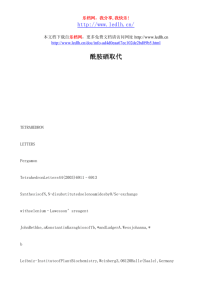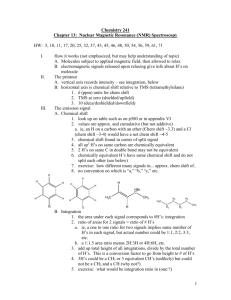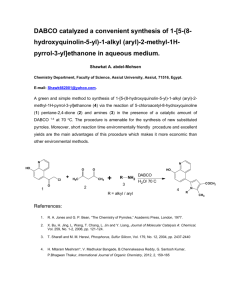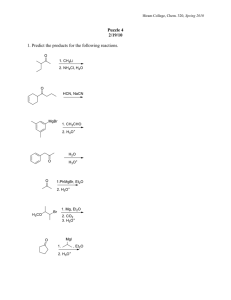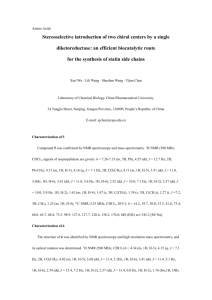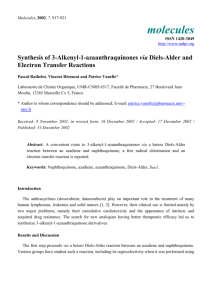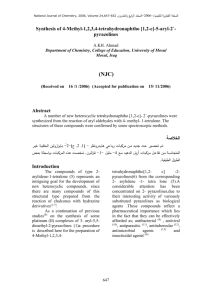Experimental details - Royal Society of Chemistry
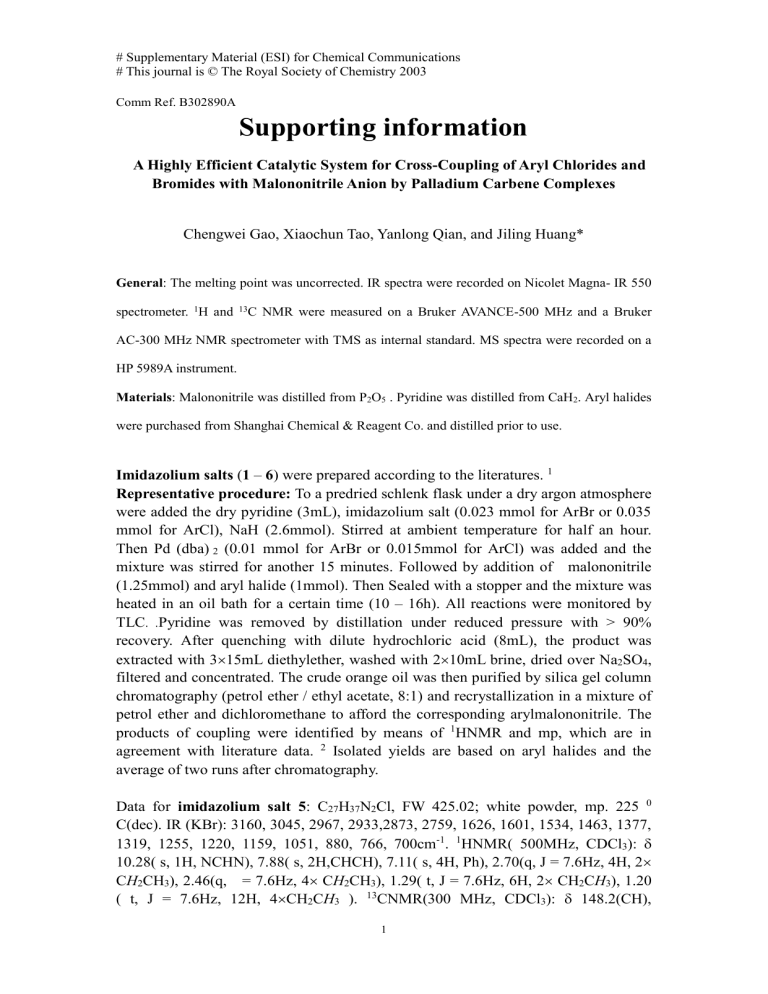
# Supplementary Material (ESI) for Chemical Communications
# This journal is © The Royal Society of Chemistry 2003
Comm Ref. B302890A
Supporting information
A Highly Efficient Catalytic System for Cross-Coupling of Aryl Chlorides and
Bromides with Malononitrile Anion by Palladium Carbene Complexes
Chengwei Gao, Xiaochun Tao, Yanlong Qian, and Jiling Huang*
General : The melting point was uncorrected. IR spectra were recorded on Nicolet Magna- IR 550 spectrometer. 1 H and 13 C NMR were measured on a Bruker AVANCE-500 MHz and a Bruker
AC-300 MHz NMR spectrometer with TMS as internal standard. MS spectra were recorded on a
HP 5989A instrument.
Materials : Malononitrile was distilled from P
2
O
5
.
Pyridine was distilled from CaH
2
. Aryl halides were purchased from Shanghai Chemical & Reagent Co. and distilled prior to use.
Imidazolium salts ( 1 – 6 ) were prepared according to the literatures.
1
Representative procedure: To a predried schlenk flask under a dry argon atmosphere were added the dry pyridine (3mL), imidazolium salt (0.023 mmol for ArBr or 0.035 mmol for ArCl), NaH (2.6mmol). Stirred at ambient temperature for half an hour.
Then Pd (dba)
2
(0.01 mmol for ArBr or 0.015mmol for ArCl) was added and the mixture was stirred for another 15 minutes. Followed by addition of malononitrile
(1.25mmol) and aryl halide (1mmol). Then Sealed with a stopper and the mixture was heated in an oil bath for a certain time (10 – 16h). All reactions were monitored by
TLC . .
Pyridine was removed by distillation under reduced pressure with > 90% recovery. After quenching with dilute hydrochloric acid (8mL), the product was extracted with 3
15mL diethylether, washed with 2
10mL brine, dried over Na
2
SO
4
, filtered and concentrated. The crude orange oil was then purified by silica gel column chromatography (petrol ether / ethyl acetate, 8:1) and recrystallization in a mixture of petrol ether and dichloromethane to afford the corresponding arylmalononitrile. The products of coupling were identified by means of
1
HNMR and mp, which are in agreement with literature data.
2
Isolated yields are based on aryl halides and the average of two runs after chromatography.
Data for imidazolium salt 5 : C
27
H
37
N
2
Cl, FW 425.02; white powder, mp. 225
0
C(dec). IR (KBr): 3160, 3045, 2967, 2933,2873, 2759, 1626, 1601, 1534, 1463, 1377,
1319, 1255, 1220, 1159, 1051, 880, 766, 700cm
-1
.
1
HNMR( 500MHz, CDCl
3
):
10.28( s, 1H, NCHN), 7.88( s, 2H,CHCH), 7.11( s, 4H, Ph), 2.70(q, J = 7.6Hz, 4H, 2
C H
2
CH
3
), 2.46(q, = 7.6Hz, 4
( t, J = 7.6Hz, 12H, 4
CH
2
C
C
H
H
3
2
CH
3
), 1.29( t, J = 7.6Hz, 6H, 2
CH
).
13
2
C H
3
), 1.20
CNMR(300 MHz, CDCl
3
):
148.2(CH),
1
# Supplementary Material (ESI) for Chemical Communications
# This journal is © The Royal Society of Chemistry 2003
140.1(CH), 138.9(C), 129.6(C), 127.1(C), 126.1(CH), 29.0(CH
2
), 24.5(CH
2
),
15.5(CH
3
), 15.2(CH
3
) . MS e/z (%): 389(M-Cl, 15), 388(M-Cl –1, 60), 387(M-Cl –2,
100), 371(10), 359(M-CH
2
CH
2
, 7), 201(14%), 188(52), 186(22), 172(16), 160(8),
144(5), 115(6), 105(5), 91(4), 77(3), 64(23), 48(8).
Data for imidazolium salt 6 : C
33
H
49
N
2
Cl, 509.18, white powder, mp.230
0
C (dec).
IR (KBr): 3133, 3062, 2964, 2929, 1637, 1602, 1539, 1465, 1364, 1326, 1224, 1184,
1103, 1053, 939, 884, 797, 694cm
-1
.
1
HNMR(500MHz, CDCl
3
):
9.38(s, 1H), 8.22( s,
2H), 7.18( s, 4H), 2.99(sept, J = 7Hz, 2H, 2
C H (CH
3
)
2
), 2.45(bs, 4H, 4
C H (CH
3
)
2
),
1.31( d, J = 6.8Hz, 24H, 4
CH(C H
3
)
2
), 1.23( d, J = 7Hz, 12H, 2
CH(C H
3
)
2
).
13 CNMR(300 MHz, CDCl
3
):
153.2(CH), 144.9(CH), 138.0(C), 127.8(C), 127.3(C),
122.8(CH), 34.7(CH
2
), 29.3(CH
2
), 24.9(CH
3
), 24.0(CH
3
), 23.9(CH
3
). MS e/z (%):
473((M-Cl, 12), 472(M-Cl-1, 51), 471(M-Cl-2, 100), 457(12), 441(8), 429(4), 387(3),
381(2), 269(2), 244(4), 230(24), 228(43), 200(22), 188(13), 186(10), 172(5), 146(6),
129(2), 91(3), 43(4).
1 W.A. Herrmann, L.J. Gossen, C. Köcher and G.R.J. Artus, Angew. Chem., Int. Ed. Engl .
1996, 35 , 2805; A.J. Arduengo III, R, Krafczyk and R. Schmutzler, Tetrahedron, 1999, 55 ,
14523; A.J. Arduengo III, H.V.R. Dias, R.L. Harlow and M. Kline, J. Am. Chem. Soc.,
1992, 112 , 5530.
2 W. A. Davis and M. P. Cava, J. Org. Chem . 1983, 48 , 2774; E. B. Troughton, K. E.
Molter and E. M. Arnett, J. Am. Chem. Soc . 1984, 106 , 6726; T. Shigetoshi, M. Uno, S.
Koji, JP 60197650 A2(1985); T. Shigetoshi, M. Uno, S. Koji, JP 60294753 A2 ( 1985);
M. A. Ciufolini and M. E. Browne, Tetrahedron lett., 1987, 28 , 171; D.H.R. Barton,
D.M.X. Donnelly, J.-P. Finet and P.H. Stenson, Tetrahedron , 1988, 44 , 6387; K. Okuro,
M. Furuune, M. Miura and M. Nomura, J. Org. Chem., 1993, 58 , 7606; G.J. Quallich,
T.W. Makoski, A.F. Sanders, F.J. Urban and E. Vazquez, J. Org. Chem., 1998, 63 , 4116.
2



